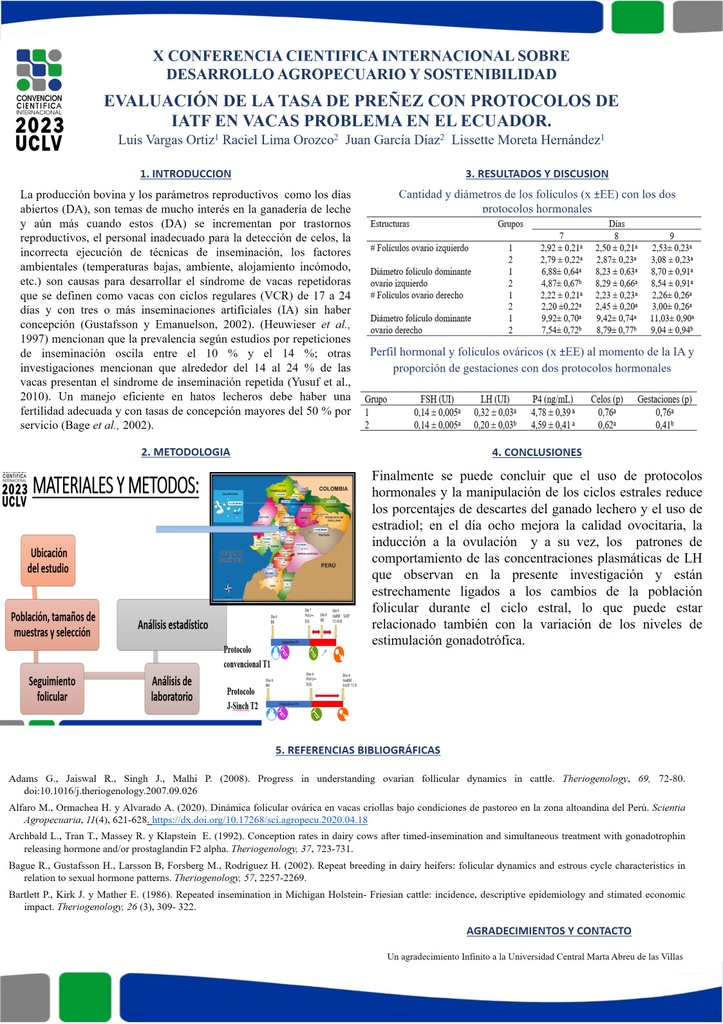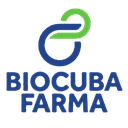Executive Secretary

9th International Scientific Conference on Agricultural Development and Sustainability
10th Symposium of Veterinary Medicine and Zootechnics

Abstract
The objective of the present study was to evaluate the conception rate in repeat cows with more than three services above 3,000 meters above sea level, applying two conventional fixed-time insemination (FTAI) protocols and modified with prolonged pro-estrus, for which 50 cows were used. of dairy farmers, the number of follicles in the ovaries was evaluated for the two treatments (P> 0.05), while for the diameter of the follicles in the right ovary it is obtained (P< 0.05) from the removal of the implant and that on the day 8 there is a growth of 0.63 mm and on day nine it is 1.99 mm larger for T1 compared to T2, for the percentage of pregnancies and the LH hormone levels differed between the treatments (p<0.05 ) for T1 (0.76%), (0.32 IU/ml) while for T2 (0.41%), (0.20 IU/ml) respectively, in the logistic regression that was carried out, observes that the cows that were in heat were 22.30 times more likely to become pregnant than those that were not in heat and that the increase in the hormonal concentrations of estradiol and LH at the time of IATF and P4 was 1.51; 53.31 and 3.95 times more likely to become pregnant. Finally, it can be concluded that the use of hormonal protocols and the manipulation of estrous cycles reduces the culling percentages of dairy cattle and the use of estradiol on day 8 improves oocyte quality and gestation percentage compared to T2.
Resumen
El objetivo del presente estudio fue evaluar la tasa de concepción en vacas repetidoras con más de tres servicios sobre los 3.000 msnm aplicando dos protocolos de inseminación a tiempo fijo (IATF) convencionales y modificado con pro-estro prolongado, para lo cual se utilizaron 50 vacas de lecheras, se evaluó la cantidad de folículos en los ovarios para los dos tratamientos (P> 0.05), mientras que para el diámetro de los folículos en el ovario derecho se obtiene (P< 0.05) desde el retiro de implante y que al día 8 hay un crecimiento de 0,63 mm y en el día nueve es de 1,99 mm más grande para el T1 en comparación de T2, para el porcentaje de gestaciones y los niveles hormonales LH difirió entre los tratamiento (p<0,05) para el T1 (0,76 %), (0,32 UI/ml ) mientras que para el T2 (0,41%), (0,20 UI/ml) respectivamente, en la regresión logística del que se realizó se observa que las vacas que presentaron celo, tuvieron 22,30 más probabilidades de quedar gestantes que las que no manifestaron celo y que el incremento de las concentraciones hormonales de estradiol y LH al momento IATF y de la P4 tuvieron 1,51; 53,31 y 3,95 veces más las probabilidades de quedaran gestantes. Finalmente se concluye que el uso de protocolos hormonales y la manipulación de los ciclos estrales reduce los porcentajes de descartes del ganado lechero y el uso de estradiol en el día 8 mejora la calidad ovocitaria y el porcentaje de gestación en comparación del T2.
About The Speaker

Dr. Luis Miguel Vargas Ortiz

Discussion

